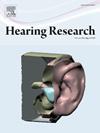耳蜗健康改变豚鼠的极性效应和尖峰起始位点
IF 2.5
2区 医学
Q1 AUDIOLOGY & SPEECH-LANGUAGE PATHOLOGY
引用次数: 0
摘要
虽然人工耳蜗(CIs)历来使用阴极引导脉冲进行刺激,但对人类的研究发现,阳极引导脉冲比阴极引导脉冲更响亮。模型研究表明,阴极脉冲比阳极脉冲更能激发周围螺旋神经节神经元(SGNs)。因此,人类CI听者的阳极效益被认为反映了退化的外围过程。我们使用动物模型来测试sgn的外周树突和中央轴突在CI刺激中对极性有效性的贡献。我们机械损伤了SGN(~ 400µm直径;n = 18只耳蜗),并引入9天的变性时间(n = 13只耳蜗)来模拟人类SGN变性。将这些病变与20只对照耳进行比较。我们通过一个豚鼠调节的CI,以对称的,双相脉冲(单极模式)交替的导相极性(50µs/相位)进行刺激。在分析中,分离了阳极和阴极引线脉冲的电诱发复合动作电位记录,计算极性效应。我们证实了具有健康SGN的耳蜗的阴极获益(更低的阈值、更大的振幅、动态范围和更陡的斜率)。到阴极的潜伏期(50-70µs)比阳极单相和双相脉冲长,证实了外围(阴极)和中心(阳极)峰起始点。在急性损伤后,阴极的好处仍然存在,这延长了阳极的潜伏期,而不是阴极的脉冲,这与被两个极性激发的剩余结构一致。慢性变性后,阈值显示极性特异性变化,导致阳极获益。观察到的阴极有效性下降与神经健康下降证实了在刺激极性和退化型依赖性峰起始位点变化的人类CI使用者的理论考虑。本文章由计算机程序翻译,如有差异,请以英文原文为准。

Cochlear health alters the polarity effect and spike-initiation sites in guinea pigs
While cochlear implants (CIs) historically use cathodic-leading pulses for stimulation, studies in humans found that anodic-leading pulses are perceived louder than cathodic-leading ones. Modeling studies proposed that cathodic pulses excite the spiral ganglion neurons (SGNs) more peripherally than anodic pulses. Thus, the anodic-benefit in human CI listeners is thought to reflect degenerated peripheral processes.
We used an animal model to test the contributions of peripheral dendrites and central axons of SGNs to polarity-effectiveness in CI stimulation. We mechanically lesioned the SGN (∼400 µm diameter; n = 18 cochleae) and introduced a 9-day degeneration time (n = 13 cochleae) to mimic human SGN degeneration. These lesions were compared to 20 control ears. We stimulated via a guinea-pig adjusted CI with symmetric, biphasic pulses (monopolar mode) of alternating leading-phase polarity (50µs/phase). Electrically-evoked compound action potential recordings to anodic- and cathodic-leading pulses were separated in the analysis to calculate the polarity effect.
We confirmed the cathodic-benefit for cochleae with healthy SGN (lower threshold, larger amplitudes, dynamic ranges, and steeper slopes). Longer latencies (50–70µs) to cathodic than anodic monophasic and biphasic pulses confirmed the proposed peripheral (cathodic) and central (anodic) spike-initiation sites. The cathodic benefit persisted after acute lesioning, which prolonged latencies for anodic- but not for cathodic-leading pulses – consistent with remaining structures being excited by both polarities. After chronic degeneration, the threshold showed polarity-specific changes, leading to an anodic-benefit.
The observed decline in cathodic-effectiveness with reduced neural health confirmed theoretical considerations for human CI users with stimulus-polarity and degeneration-type dependent changes in spike-initiation site.
求助全文
通过发布文献求助,成功后即可免费获取论文全文。
去求助
来源期刊

Hearing Research
医学-耳鼻喉科学
CiteScore
5.30
自引率
14.30%
发文量
163
审稿时长
75 days
期刊介绍:
The aim of the journal is to provide a forum for papers concerned with basic peripheral and central auditory mechanisms. Emphasis is on experimental and clinical studies, but theoretical and methodological papers will also be considered. The journal publishes original research papers, review and mini- review articles, rapid communications, method/protocol and perspective articles.
Papers submitted should deal with auditory anatomy, physiology, psychophysics, imaging, modeling and behavioural studies in animals and humans, as well as hearing aids and cochlear implants. Papers dealing with the vestibular system are also considered for publication. Papers on comparative aspects of hearing and on effects of drugs and environmental contaminants on hearing function will also be considered. Clinical papers will be accepted when they contribute to the understanding of normal and pathological hearing functions.
 求助内容:
求助内容: 应助结果提醒方式:
应助结果提醒方式:


